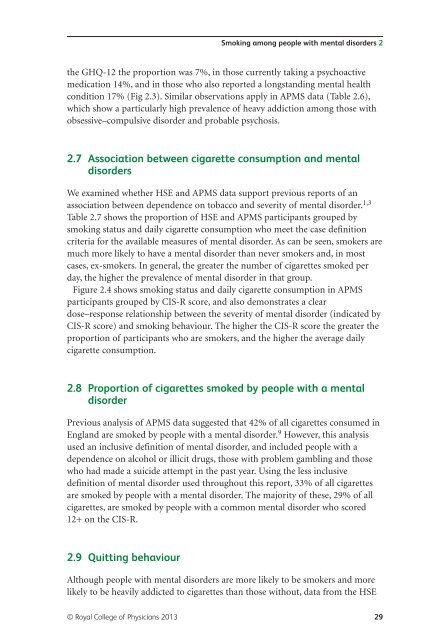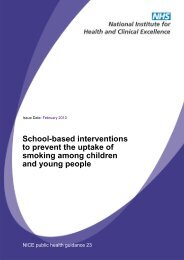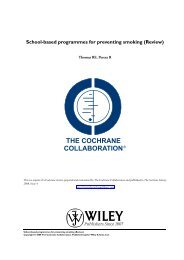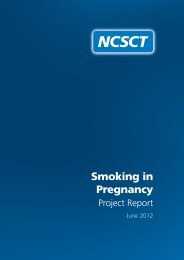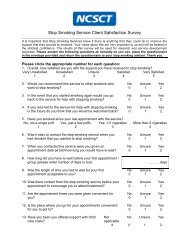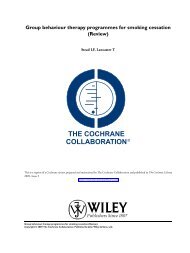Smoking and mental health - NCSCT
Smoking and mental health - NCSCT
Smoking and mental health - NCSCT
You also want an ePaper? Increase the reach of your titles
YUMPU automatically turns print PDFs into web optimized ePapers that Google loves.
<strong>Smoking</strong> among people with <strong>mental</strong> disorders 2<br />
the GHQ-12 the proportion was 7%, in those currently taking a psychoactive<br />
medication 14%, <strong>and</strong> in those who also reported a longst<strong>and</strong>ing <strong>mental</strong> <strong>health</strong><br />
condition 17% (Fig 2.3). Similar observations apply in APMS data (Table 2.6),<br />
which show a particularly high prevalence of heavy addiction among those with<br />
obsessive–compulsive disorder <strong>and</strong> probable psychosis.<br />
2.7 Association between cigarette consumption <strong>and</strong> <strong>mental</strong><br />
disorders<br />
We examined whether HSE <strong>and</strong> APMS data support previous reports of an<br />
association between dependence on tobacco <strong>and</strong> severity of <strong>mental</strong> disorder. 1,3<br />
Table 2.7 shows the proportion of HSE <strong>and</strong> APMS participants grouped by<br />
smoking status <strong>and</strong> daily cigarette consumption who meet the case definition<br />
criteria for the available measures of <strong>mental</strong> disorder. As can be seen, smokers are<br />
much more likely to have a <strong>mental</strong> disorder than never smokers <strong>and</strong>, in most<br />
cases, ex-smokers. In general, the greater the number of cigarettes smoked per<br />
day, the higher the prevalence of <strong>mental</strong> disorder in that group.<br />
Figure 2.4 shows smoking status <strong>and</strong> daily cigarette consumption in APMS<br />
participants grouped by CIS-R score, <strong>and</strong> also demonstrates a clear<br />
dose–response relationship between the severity of <strong>mental</strong> disorder (indicated by<br />
CIS-R score) <strong>and</strong> smoking behaviour. The higher the CIS-R score the greater the<br />
proportion of participants who are smokers, <strong>and</strong> the higher the average daily<br />
cigarette consumption.<br />
2.8 Proportion of cigarettes smoked by people with a <strong>mental</strong><br />
disorder<br />
Previous analysis of APMS data suggested that 42% of all cigarettes consumed in<br />
Engl<strong>and</strong> are smoked by people with a <strong>mental</strong> disorder. 9 However, this analysis<br />
used an inclusive definition of <strong>mental</strong> disorder, <strong>and</strong> included people with a<br />
dependence on alcohol or illicit drugs, those with problem gambling <strong>and</strong> those<br />
who had made a suicide attempt in the past year. Using the less inclusive<br />
definition of <strong>mental</strong> disorder used throughout this report, 33% of all cigarettes<br />
are smoked by people with a <strong>mental</strong> disorder. The majority of these, 29% of all<br />
cigarettes, are smoked by people with a common <strong>mental</strong> disorder who scored<br />
12+ on the CIS-R.<br />
2.9 Quitting behaviour<br />
Although people with <strong>mental</strong> disorders are more likely to be smokers <strong>and</strong> more<br />
likely to be heavily addicted to cigarettes than those without, data from the HSE<br />
© Royal College of Physicians 2013 29


